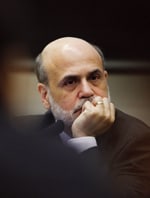UNITED STATES
By Gordon Platt
 |
|
Taking a new tack: Ben Bernanke, Fed chairman |
Fed watchers around the world were surprised in August when the Federal Open Market Committee announced a decision to target the Federal Reserve’s balance sheet, rather than reserves or interest rates, as its key lever of monetary policy. In what some are calling QE2, or Quantitative Easing Lite, the FOMC voted to reinvest its maturing agency and mortgage-backed securities into treasuries to keep its balance sheet from shrinking. This means that the Fed has stopped looking for an exit strategy, at least for the time being, and is concerned about the slow pace of the economic recovery. The recycling of agency and MBS was the most significant aspect of the FOMC’s statement, although it repeated that it would keep interest rates low for an extended period.
The committee’s decision to target the Fed’s balance sheet is as important as the decision by the “Volcker Fed” on October 6, 1979, to target reserves, says Dennis Gartman, editor and publisher of “The Gartman Letter” advisory service. In what became known as “The Saturday Night Massacre,” then-chairman Paul Volcker announced a change in Fed policy that sent interest rates soaring. Volcker said the Fed would allow the funds rate to seek its own level to stamp out inflationary pressures.
The current FOMC has chosen to make its operational activities clearer and easier to understand, Gartman says. “Simply put, we will know without equivocation, in the months and years ahead, what the Fed is doing by keeping hard track of its portfolio,” he says. “Should the Fed’s balance sheet tip upward in the future, then we shall know without debate that it has eased; if its balance sheet has fallen, we shall know that it has tightened policy. There can be no debate henceforth.”
If the Fed allows its balance sheet to shrink at the same time that fiscal policy is tightening, it could risk repeating its mistake of 1937, when it raised reserve requirements and the discount rate, pushing the economy back into the Depression.



